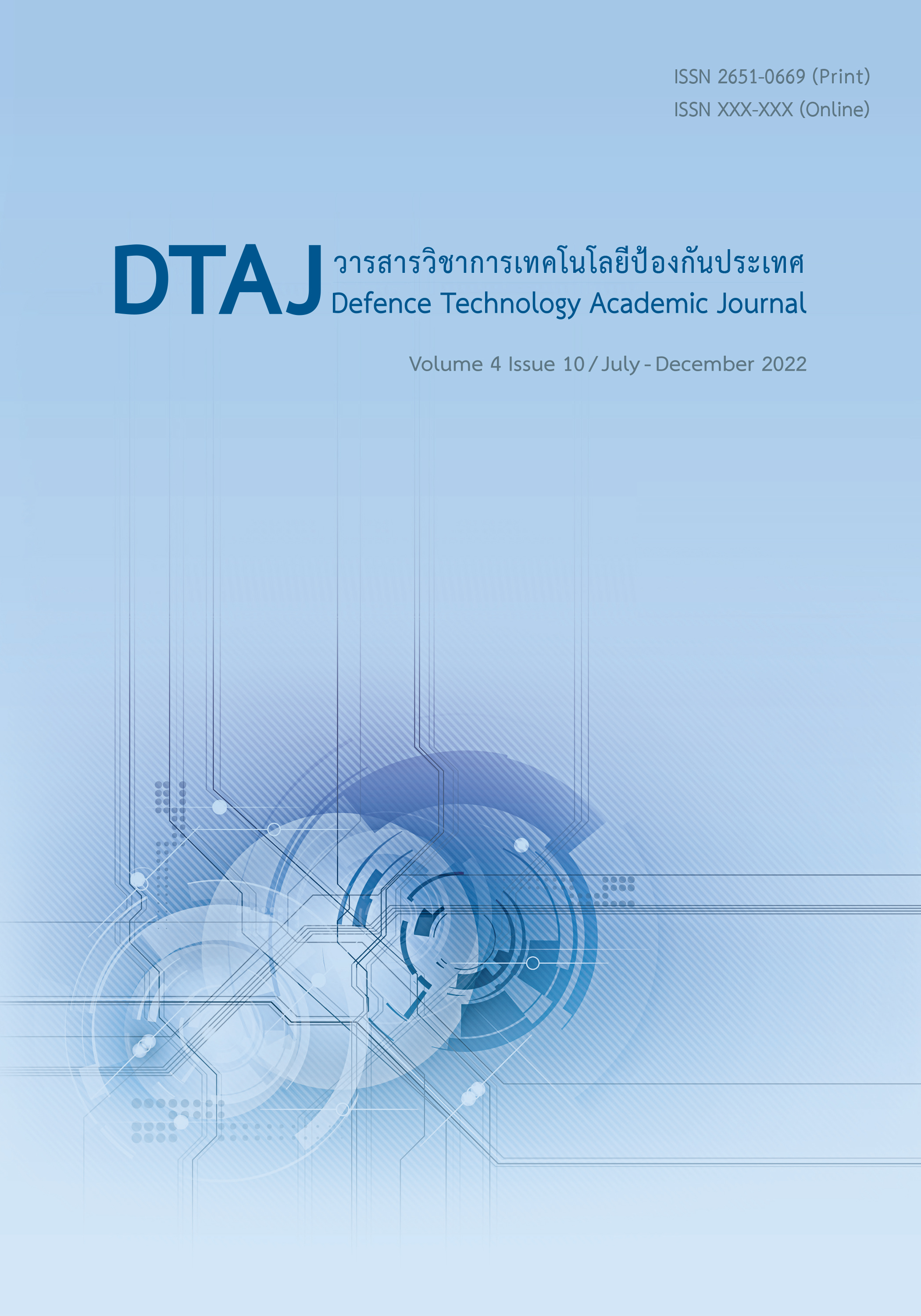Landslide Susceptibility Assessment in Khao Yai National Park
Main Article Content
Abstract
This study aims to create landslide susceptibility map using the integration of Remote Sensing (RS) data, Geographical Information Systems (GIS), and Analytical Hierarchy Process (AHP)atKhaoYai NationalPark.Theresults werefound that themost factor influencing to landslide activities was slope, followed by precipitation, distance from road, elevation, distance from drainage, lithology, aspect, curvature and Topographic Wetness Index (TWI) respectively. With the consideration of these influenced factors, the susceptibility landslide area wasclassed into5classesasveryhigh(0.31km2 ),high(15.23km2 ), moderate(218.36km2 ), low (1,681.07 km2 ) and lowest (269.89 km2 ) respectively with the overall accuracy of 85.37% and Kappa coefficient of 0.71. This accuracy assessment revealed the level of landslide susceptibility map accuracy is useful for planning and decision-making in order to monitor and cope with landslide occurrence in the future at Khao Yai National Park.
Downloads
Article Details

This work is licensed under a Creative Commons Attribution-NonCommercial-NoDerivatives 4.0 International License.
Journal of TCI is licensed under a Creative Commons Attribution-NonCommercial-NoDerivatives 4.0 International (CC BY-NC-ND 4.0) licence, unless otherwise stated. Please read our Policies page for more information...
References
H. Shahabi and M. Hashim, “Landslide Susceptibility Mapping Using GIS-based Statistical Models and Remote Sensing Data in Tropical Environment,” Sci. Rep., vol. 5, no. 9899, pp. 1 - 15, 2015.
A. Wubalem, “Landslide Susceptibility Mapping Using Statistical Methods in Uatzau Catchment Area, Northwestern Ethiopia,” Geoenvironmental Disasters, vol. 8, no. 1, pp. 1 - 21, 2021.
K. Suk-ueng, B. Phrommarat, S. Nanglae, T. Changruenngam, and S. Sudsanit, “MappingofLandslideSusceptibility Area Using Geographic Information System and Logistic Regression Model with Environmental Factors: A Case Study of Ban Nanglae Nai, Muang District, Chiang Rai Province,” Veridian E-J. Sci. Technol. Silpakorn Univ., vol. 4, no. 6, pp. 1 - 10, 2017.
A. Abay, G. Barbieri, and K. Woldearegay, “GIS-based Landslide Susceptibility Evaluation Using Analytical Hierarchy Process (AHP) Approach: The Case of Tarmaber District, Ethiopia,” Momona Ethiop. J. Sci., vol. 11, no. 1, p. 14, 2019.
Y. Achour, A. Boumezbeur, R. Hadji, A. Chouabbi,V.Cavaleiro,andE.A.Bendaoud, “Landslide Susceptibility Mapping Using Analytic HierarchyProcessand Information Value Methods Along a Highway Road Section in Constantine, Algeria,” Arab. J. Geosci., vol. 10, pp. 1 - 16, 2017.
N. Rakkapao, P. Plodpai, K. Boonma, and P.Wimonsong,“LandslideRisk Assessment Using Geographic Information System: A CaseStudyofPhanomDistrict,SuratThani Province, Thailand,” J. Spat. Innov. Dev., vol. 1, no. 1, pp. 74 - 82, 2020.
M. Mehrabi and H. Moayedi, “Landslide Susceptibility Mapping Using Artificial Neural Network Tuned by Metaheuristic Algorithms,” Environ. Earth Sci., vol. 80, no. 804, pp. 1-20, 2021.
D.Schulz,H.Yin,B.Tischbein,S.Verleysdonk, R. Adamou, and N. Kumar, “Land Use Mapping Using Sentinel-1 and Sentinel-2 TimeSeries ina HeterogeneousLanscape in Niger, Sahel,” ISPRS J. Photogramm. Remote Sens.,vol.178, pp.97-111,2021.
C. J. van Westen, E. Castellanos, and S.L.Kuriakose,“Spatial DataforLandslide Susceptibility, Hazard, and Vulnerability Assessment: An Overview,” Eng. Geol., vol. 102, no. 3 - 4, pp. 112 - 131, 2008.
P. Pradabmook and T. Laosuwan, “The Integration of Geo-informatics Technology with Universal Soil Loss Equationto Analyze AreasPronetoSoil Erosion in Nan province,” ARPN J. Eng. Appl. Sci.,vol.16,no.8, pp.823-830,2021.
E.Psomiadis,A.Papazachariou,K.X.Soulis, D. S. Alexiou, and I. Charalampopoulos, “Landslide Mapping and Susceptibility Assessment Using Geospatial Analysis and Earth Observation Data,” Land, vol. 9, p. 133, 2020.
J. Brock, P. Schratz, H. Petschko, J. Muenchow,M.Micu,and A.Brenning,“The PerformanceofLandslideSusceptibility Models Critically Dependsonthe Quality of DigitalElevation Models,” Geomatics, Nat. Hazards Risk, vol. 11, no. 1, pp. 1075 – 1092, 2020.
Z. Chen,F.Ye, W.Fu,Y.Ke,and H. Hong, “TheInfluenceof DEMSpatialResolution on Landslide Susceptibility Mapping in the Baxie River Basin, NW China,” Nat. Hazards,vol.101, pp.853-877,2020.
J.RoyandS.Saha,“LandslideSusceptibility Mapping Using Knowledge Driven Statistical Models in Darjeeling District, WestBengal, India,” Geoenvironmental Disasters, vol. 6,no. 11, pp. 1–18, 2019.
P. Jeefoo, N. Sangnoppakun, and R.Thongouam,“Assessmentof Wildfire RiskZonationUsingAnalyticalHierarchical Process in Phayao Province,” J. Spat. Innov. Dev.,vol.2,no.2, pp.52-64,2021.
T. L. Saaty, The Analytic Hierarchy Process, McGraw-Hill, Ed., New York, NY, USA: Scientific Research Publishing, 1980.
A.E. Jazouli, A.Barakat,and R.Khellouk, “GIS-multicriteria Evaluation Using AHP for Landslide Susceptibility Mapping in Oum Er Rbia High Basin (Morocco),” Geoenvironmental Disasters, vol. 6, no. 3, pp. 1 - 12, 2019.
N. Yossanthia, A. Tangsiriwattanawong, A.Thamboon,K.Khlueabsungnoen,and J. Som-ard, “Analyzing the Villages into Landslide Risk Area in Loei Province,” in The 13th Mahasarakham Univ. Res. Conf., 2017, pp. 598 – 609.
I. Sonker, J. N. Tripathi, and A. K. Singh, “LandslideSusceptibility Zonation Using Geospatial Technique and Analytical Hierarchy Process in Sikkim Himalaya,” Quat. Sci. Adv., vol. 4, pp. 1 - 17, 2021.
P. Khiaosalab and P. Tongdeenok, “Application Techniques Analytic Hierarchy Process and Geographic Information System Comparison Susceptible Landslide Area in Huai Mae Saroi Watershed, Phrae Province and Khlong Tha Thon Watershed, Nakhon Si Thammarat Province,” KKU Res. J. Grad. Stud., vol. 15, no. 1, pp. 63 – 79, 2015.


